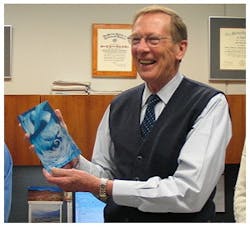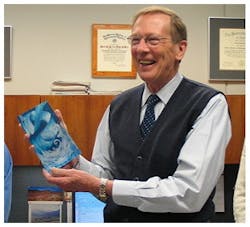Turn on the tap; clean water comes out. Flush the toilet; it goes away. To many end users, this may very well be the extent of their understanding of the water and wastewater industry. But the technology behind the treatment, collection, and distribution of water is, in fact, quite complex - and the creative individuals who give birth to the ideas that make it seem so simple are nothing short of awe inspiring.
Last month, at WEFTEC in Chicago, I had the opportunity to meet one of these individuals. Dr. James Barnard, often referred to as the 'father of biological nutrient removal,' pioneered the process that today is used in thousands of wastewater treatment plants around the world to remove nitrogen and phosphorus without the use of chemicals.
His work earned him the prestigious Lee Kuan Yew Water Prize in 2011, an award that recognizes outstanding contributions towards solving global water problems.
I asked Dr. Barnard about his beginnings as a pioneer in wastewater treatment and how he got started down the path that ultimately led to where he is today, a Water Global Practice Leader and Senior Process Specialist with Black & Veatch. He recalled a time in the late 1960s when eutrophication of water bodies - like Lake Erie - was getting very serious. "I was at the University of Texas and you could buy stickers [that] said 'the Dead Sea is alive and living in Lake Erie.'"
Shortly thereafter, Dr. Barnard returned to South Africa, where the city of Johannesburg was experiencing a tremendous challenge with its drinking water supply. "These reservoirs were turning green. Pea soup green," he said. "We knew at the time that the problem was excess phosphorus. But we didn't know how to take it out."
Dr. Barnard began experimenting, looking for a way to use biology - not chemicals - to remove the phosphorus.
He first discovered how to remove nitrogen without the use chemicals. The City of Johannesburg decided to build a new treatment plant based on his technology and set up a pilot plant. "I was working on the pilot plant and I discovered that there was also phosphorus removal taking place!" he recalled. "Then it took me another two years to figure out how this happened."
Dr. Barnard was quick to acknowledge that his work did not happen in isolation. "You don't start in a vacuum," he said. "Phosphorus removal had been observed at a number of plants in the U.S., but nobody could explain why." His mission became identifying the link, the common factors that resulted in the removal of phosphorus.
With persistence and determination, Dr. Barnard at last was able to connect the dots. "In phosphorus removal, you have these specialist bacteria that can take up enormous quantities of phosphorus. [They] could really store an excessive amount and what we found is that when ... we grow them, they slurp up the phosphorus in the liquid. Then you take them out and the phosphorus is removed out of the liquid. And it's all without chemicals."
In the forty plus years since Dr. Barnard's discovery, acceptance and adoption of biological nutrient removal has grown - despite much skepticism in its early days. And by all indications, it will continue to evolve.
"We're going work with Chicago Metropolitan Water District to recover all the phosphorus from their wastewater," said Dr. Barnard. With nutrient recovery technology from Ostara, the phosphorus will be turned into beneficial fertilizer.
"And that's the beautiful thing about phosphorus: instead of taking it out of the liquid and then polluting something else, [we can] recover the phosphorus and use it.
"It's all part of seeing wastewater treatment plants more as resources," he said.
A very exciting trend, indeed.
Chief Editor, WaterWorld





